The Velay Region in Haute-Loire |

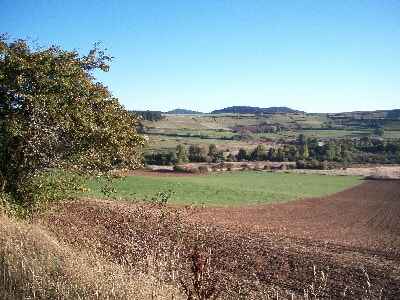 Located on either side of the Loire Valley, the high plateaus of Velay offer a landscape of great variety. The usual arrangement of morphostructural units of the Massif Central can be observed: a metamorphic and granitic base, intersected by small tertiary tectonic basins, locally topped with a volcanic cover. Topographically, the diversity is even greater: the highly dissected and multifaceted model of the Chaise-Dieu plateau contrasts with the vast flat spaces of basalt flows; the gorges of the Allier and Loire within the base contrast sharply with the broad valleys that traverse the chains of tectonic basins; the volcanic formations and peaks surprise by the steepness of their slopes.
Located on either side of the Loire Valley, the high plateaus of Velay offer a landscape of great variety. The usual arrangement of morphostructural units of the Massif Central can be observed: a metamorphic and granitic base, intersected by small tertiary tectonic basins, locally topped with a volcanic cover. Topographically, the diversity is even greater: the highly dissected and multifaceted model of the Chaise-Dieu plateau contrasts with the vast flat spaces of basalt flows; the gorges of the Allier and Loire within the base contrast sharply with the broad valleys that traverse the chains of tectonic basins; the volcanic formations and peaks surprise by the steepness of their slopes.
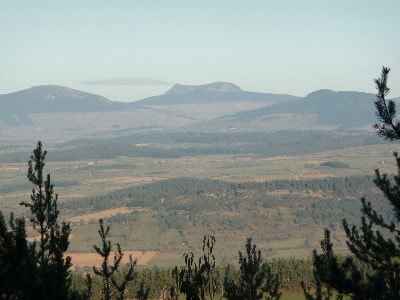 While the historical unit is without doubt, clearly framed around the town of Le Puy en Velay, the regional geographical boundaries are less distinct: one transitions seamlessly from the Chaise-Dieu plateau to that of Livradois to the north and to the south, from the Mézenc massif to high Ardèche; the basins of Langeac and Brioude resemble the Limagne of Issoire; the only two clear cuts are the valley of the Allier to the west, facing Margeride, and the abrupt edge above the Rhône slope.
While the historical unit is without doubt, clearly framed around the town of Le Puy en Velay, the regional geographical boundaries are less distinct: one transitions seamlessly from the Chaise-Dieu plateau to that of Livradois to the north and to the south, from the Mézenc massif to high Ardèche; the basins of Langeac and Brioude resemble the Limagne of Issoire; the only two clear cuts are the valley of the Allier to the west, facing Margeride, and the abrupt edge above the Rhône slope.
Three natural regions, each with well-defined characteristics, are clearly delineated; to the west, the Devès; to the east, the eastern Velay sometimes referred to as the Mézenc plateau; and at the center, the basin of Le Puy.
The architecture of the western Velay is characterized by great simplicity: a high plateau, between the Allier and the valleys of the Loire and Borne, serves as a pedestal, at around 1,000 m altitude, for a line of volcanic structures known as the Devès chain, named after the main summit (1421 m). This is a crystalline (granite and gneiss) horst, clearly visible in the Fix-Saint-Geneys region, which has been covered by basalt flows from strombolian cones of Villafranchian age. Much older than in the Domes, the cones are worn down, and the craters are not very visible, but the structures are still clearly defined, distinctly dominating the plateaus.
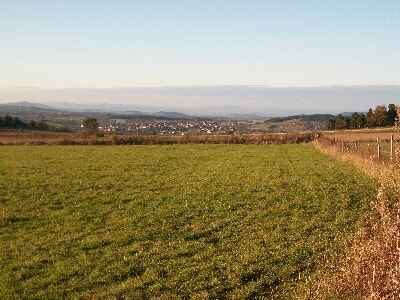 Of the same age, explosion craters also characterize this volcanism: they create circular depressions occupied by lakes (Lake Bouchet) or swampy and peaty formations (Limagne Marshes).
Of the same age, explosion craters also characterize this volcanism: they create circular depressions occupied by lakes (Lake Bouchet) or swampy and peaty formations (Limagne Marshes).
The very weathered basalt flows on the surface support andosols with high agronomic qualities. The cones no longer have the balanced slopes of their beginnings: although they still present steep sides contrasting sharply with the high flat surfaces of the basalt plateaus, long concave connections link them to these plateaus, allowing crops to rise up to mid-slope.
Similar features are found in eastern Velay: flat spaces created by overlapping basalt flows that slope from 1,200 m to less than 1,000 m to the north and west, with some explosion craters like that of Lake Saint-Front or the depression of Chaudeyrolles, but the originality here lies in the presence of elevated volcanic structures (reaching 1,753 m at Mont Mézenc), the existence of small basins like that of Saint-Julien-Chapteuil, deep and narrow valleys, and the abruptness of the contact with the "cut-off land" that transitions to the Rhône valley.
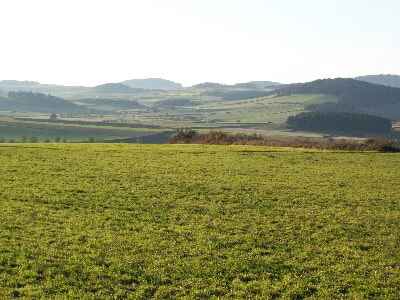 Three phonolitic massifs rise abruptly above the whole:
Three phonolitic massifs rise abruptly above the whole:
- To the north, from Saint-Julien-Chapteuil to Yssingeaux, the Meygal-Lizieux massif. To the west, it consists of about ten small isolated peaks with rounded shapes, arranged in north-south alignments; from Mont Jaurence to Mont Plaux, from Rand to Mont Chanis; to the east, Meygal and Lizieux are larger, forming a wide pedestal dominated by peaks resembling pyramids, with steep sides and bare rock; local vernacular refers to them as "sucs."
- In the center, the plateau of Roches between Fay-sur-Lignon and Saint-Front appears as a dome-flow.
- To the south, the Mont-Mézenc-Gerbier-de-Jonc ensemble where isolated peaks (Gerbier-de-Jonc, Roche-Tourte, Roche du Bachat) and heavier forms are placed on a sort of platform like at Mont Mézenc-Alambre; to the east, in the large amphitheater of valleys descending towards the Rhône, the peaks have even more upright slopes, forming large cones (Suc de Touron, Roche de Borée) or pyramids (Rocher de Pradoux, Suc de Sara).
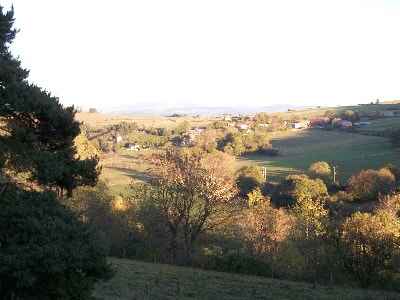 Between the high plateaus of Velay lies the basin of Le Puy. At the confluence of the valleys of the Borne and the Loire, this poorly defined basin, with altitudes always above 600 m, is cluttered with mounds and plateau elements of various shapes. The Loire Valley widens significantly here before narrowing into gorges between Peyredeyre to the north of Chadrac and Lavoûte-sur-Loire. Aside from the lower valley of Dolaison, where the modern city of Le Puy develops, the only truly extensive flat areas are to the east between Saint-Germain-la-Prade and Blavozy, as well as towards Lantriac, where they connect to the basin of Saint-Julien-Chapteuil.
Between the high plateaus of Velay lies the basin of Le Puy. At the confluence of the valleys of the Borne and the Loire, this poorly defined basin, with altitudes always above 600 m, is cluttered with mounds and plateau elements of various shapes. The Loire Valley widens significantly here before narrowing into gorges between Peyredeyre to the north of Chadrac and Lavoûte-sur-Loire. Aside from the lower valley of Dolaison, where the modern city of Le Puy develops, the only truly extensive flat areas are to the east between Saint-Germain-la-Prade and Blavozy, as well as towards Lantriac, where they connect to the basin of Saint-Julien-Chapteuil.
Elsewhere, tiered plateaus with steep edges prevail, with tops so flat that they have been referred to as "plains": such is the case with the "plain of Chambeyrac," the "plain of Rome," and the "plain of Chadrac"; above these flat elements are some convex-topped mounds called "guard" like the "guard of Ours" near Taulhac. In the midst of the best-defined depressions, peaks arise, such as the one on which the castle of Polignac was built or the famous rocks, Corneille, known as the Virgin, and Aiguilhe, which have served as the site for the town of Le Puy. The basin extends locally into deep, steep-sided valleys dominated by ledges that end abruptly upstream, resembling a retreat (valley of Ceyssac, Dolaison, or Riou).
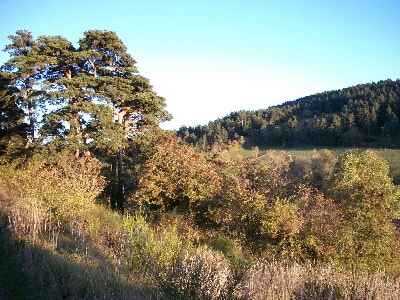 The history of the relief forms of Velay is intertwined with that of the Massif Central: the flattened Hercynian base has been fractured and uplifted in the Tertiary before being largely covered with volcanic materials. As early as the Eocene, a tectonic basin was created in the region of Brive-Charensac-Blavozy, a basin filled with fairly coarse detrital materials of the arkose type; sedimentation continued with variegated sandy clays and green and pink marls intercalated with gypsum; it ended with limestones dated to the lower Oligocene.
The history of the relief forms of Velay is intertwined with that of the Massif Central: the flattened Hercynian base has been fractured and uplifted in the Tertiary before being largely covered with volcanic materials. As early as the Eocene, a tectonic basin was created in the region of Brive-Charensac-Blavozy, a basin filled with fairly coarse detrital materials of the arkose type; sedimentation continued with variegated sandy clays and green and pink marls intercalated with gypsum; it ended with limestones dated to the lower Oligocene.
In the Miocene, sporadic and violent flows similar to those occurring in current arid regions dispersed clay-sandy alluvium containing pebbles of quartz, granite, and even flint. These can sometimes be seen trapped beneath the basalt flows. Tectonic instability continued until the Villafranchian during which two episodes of refilling can be observed: the oldest shows a predominance of fine materials, sands, and clays; the most recent also contains clays but additionally presents coarse sandbanks and conglomerates; these deposits have themselves been tilted.
From the upper Miocene to the beginning of the Quaternary, the region experienced large-scale volcanic episodes. To the east, the volcanism is characterized first by the stacking of numerous flows that cover the high granite arches and give them a flat appearance; further north, in the basin of Emblavès, there are small basalt flows and trachy-andesitic domes; in the region of Boutières, a complex stratovolcano has developed, affected by a caldera that would largely explain the amphitheater of Boutières; the most original landscapes are given by phonolitic intrusions in the form of heavy domes (Alambre, Mézenc), dome-flows (Meygal-Lizieux), protrusions (Rocher de Borée, Gerbier de Jonc), or annular structure intrusions (Rocher des Pradoux, Suc de Sara); finally, a late explosive episode complicates the whole by creating an alignment of maars (Saint-Front, Chaudeyrolles).
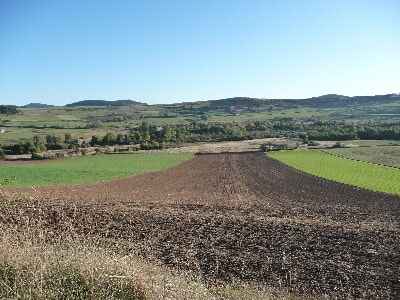 In the basin of Le Puy, the volcanism is even more original, presenting itself in the form of breccias contemporary with the first Villafranchian refilling. Formed at the bottom of a lake, these breccias were later uncovered from the soft sediments that surrounded them to create necks, true peaks that give the basin its characteristic appearance.
In the basin of Le Puy, the volcanism is even more original, presenting itself in the form of breccias contemporary with the first Villafranchian refilling. Formed at the bottom of a lake, these breccias were later uncovered from the soft sediments that surrounded them to create necks, true peaks that give the basin its characteristic appearance.
The paleoclimatic conditions in Velay have never been cold enough to allow for significant glaciation. Indeed, a trace of a glacial valley has been recognized in the upper valley of the Lignon, but it seems that the remains of a covered ancient glacier are the only undeniably glacial deposits. They are located in the valley of Entraygues, at the eastern foot of Mont Mézenc. Composed of coarse, heterogeneous, and angular material, this long accumulation, stretched along the bottom of the trough with a sharp termination, resembles the covered glaciers observed in the Alps.
On either side of Mont Mézenc, when the ridge line is above 1,300 m, the summit of the Rhône slope is etched with small amphitheaters, suspended above the main valleys: they correspond to the rearrangement of valley heads by cold processes where snow and ice have played an effective role. This phenomenon has been favored by snow accumulation; the strong winds prevailing on the high plateau swept the snow that accumulated in drifts at the top of the Rhône slope (this phenomenon can still be observed every winter).
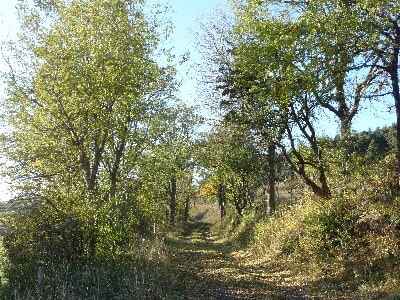 The region has been particularly marked by periglacial conditions, especially during the last cold period, and the deposits resulting from it still condition the major features of the geography today. For a long time, researchers have been drawn to the existence, especially on the slopes, of layers of block debris called "chiers," "chirats," or "clapiers" in the local language. In fact, several types of periglacial formations fringe the phonolitic massifs of high Velay: the highest parts and the steepest sectors of the flows carry beautiful sheets of debris; the rock, very prone to frost division, has been broken down into flat slabs of all sizes, generally decimetric; as they are or after being reshaped, they have been used as "lauzes" to create rustic roofs for the oldest houses in the region.
The region has been particularly marked by periglacial conditions, especially during the last cold period, and the deposits resulting from it still condition the major features of the geography today. For a long time, researchers have been drawn to the existence, especially on the slopes, of layers of block debris called "chiers," "chirats," or "clapiers" in the local language. In fact, several types of periglacial formations fringe the phonolitic massifs of high Velay: the highest parts and the steepest sectors of the flows carry beautiful sheets of debris; the rock, very prone to frost division, has been broken down into flat slabs of all sizes, generally decimetric; as they are or after being reshaped, they have been used as "lauzes" to create rustic roofs for the oldest houses in the region.
On most slopes, the blocks broken by frost have been mixed with a clayey and silty matrix that allowed them to flow during thaw periods. They form large surfaces that can be described as gelifluous due to their mode of deposition. In valleys, especially those better supplied with snow, these surfaces take on the appearance of true embankments; they can reach several meters high, up to 5-6 m; they end abruptly and may be irregularly shaped with bulges.
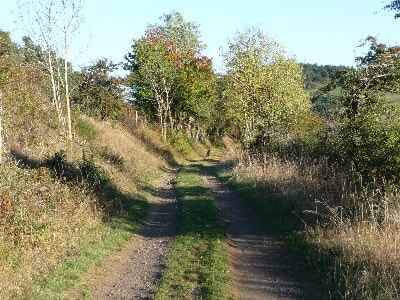 The most surprising formations encountered here resemble rivers of stones, genuine corridors of blocks and debris, extending over several hundred meters, sometimes exceeding a kilometer, with widths not exceeding several dozen meters. The thickness, a few meters, shows a pile of heterogeneous blocks, the largest on the surface and the smallest at the base, well interlocked with each other, without a matrix. Numerous bulges disrupt these rivers of stones, which end with a steep front, at constant altitudes of 1,000 to 1,100 m for Meygal (1,100 m at the Roches massif, 1,300 m at Taupernas-Lauzière-Montfol). Among the hypotheses for their formation, the most plausible seems to be that which assimilates these rivers of stones to sorts of rock glaciers whose material moved thanks to an interstitial ice cement. These are forms that have long been inactive, which explains their poor state of preservation, especially compared to those in the southern high Alps. However, these formations are rich in information; they testify to a cold and dry environment, with local permafrost, conditions that prevailed in high Velay over 18,000 years ago.
The most surprising formations encountered here resemble rivers of stones, genuine corridors of blocks and debris, extending over several hundred meters, sometimes exceeding a kilometer, with widths not exceeding several dozen meters. The thickness, a few meters, shows a pile of heterogeneous blocks, the largest on the surface and the smallest at the base, well interlocked with each other, without a matrix. Numerous bulges disrupt these rivers of stones, which end with a steep front, at constant altitudes of 1,000 to 1,100 m for Meygal (1,100 m at the Roches massif, 1,300 m at Taupernas-Lauzière-Montfol). Among the hypotheses for their formation, the most plausible seems to be that which assimilates these rivers of stones to sorts of rock glaciers whose material moved thanks to an interstitial ice cement. These are forms that have long been inactive, which explains their poor state of preservation, especially compared to those in the southern high Alps. However, these formations are rich in information; they testify to a cold and dry environment, with local permafrost, conditions that prevailed in high Velay over 18,000 years ago.
The great variety of physical conditions translates poorly on a human level; Velay indeed presents an undeniable unity. On the margins of Auvergne, at the contact with Vivarais facing the Rhône valley and the Mediterranean, it practically identifies with the department of Haute-Loire and is organized around its "capital," Le Puy, an active commercial and industrial city that radiates over all the highlands that frame it.
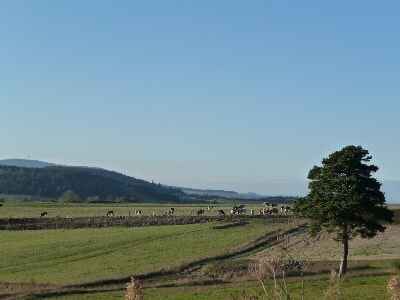 The rural world resembles the Auvergnat regions of the East and South: it is a partitioned environment, organized by small farmers, with large estates being rare. Farming and cultivation are widespread. The peasant presence is reminiscent of Livradois and Margeride. Despite the altitude, no beautiful pastoral system has developed: there is nothing comparable to Cantal or even the Monts Dore. It should be noted that this is a less humid region, in a position of relative shelter: natural grazing is less vigorous, and farming is more "encouraged," even at quite high altitudes; cereal, potato, turnip, and cabbage cultivation has largely exceeded 1,000 m in the last century, reaching its maximum altitudes in the Massif Central (1,400 m around Les Estables) on the high plateaus of Mézenc to the east. Traditionally, a bit of everything was produced to feed the family, often large. The land remains very fragmented, with small-sized ownership shared among heirs; the field, surrounded by low walls, sometimes bordered by a few trees, is often tiny. The house is modestly sized. This area is characterized by small-scale farming, although Velay has not experienced densities as high as those in nearby Livradois.
The rural world resembles the Auvergnat regions of the East and South: it is a partitioned environment, organized by small farmers, with large estates being rare. Farming and cultivation are widespread. The peasant presence is reminiscent of Livradois and Margeride. Despite the altitude, no beautiful pastoral system has developed: there is nothing comparable to Cantal or even the Monts Dore. It should be noted that this is a less humid region, in a position of relative shelter: natural grazing is less vigorous, and farming is more "encouraged," even at quite high altitudes; cereal, potato, turnip, and cabbage cultivation has largely exceeded 1,000 m in the last century, reaching its maximum altitudes in the Massif Central (1,400 m around Les Estables) on the high plateaus of Mézenc to the east. Traditionally, a bit of everything was produced to feed the family, often large. The land remains very fragmented, with small-sized ownership shared among heirs; the field, surrounded by low walls, sometimes bordered by a few trees, is often tiny. The house is modestly sized. This area is characterized by small-scale farming, although Velay has not experienced densities as high as those in nearby Livradois.
Despite significant emigration, the demographic peak has often been late. Farms have slowly expanded, and fidelity to small-scale polyculture remains in certain parts of Velay. Tradition lingers on these high plateaus.
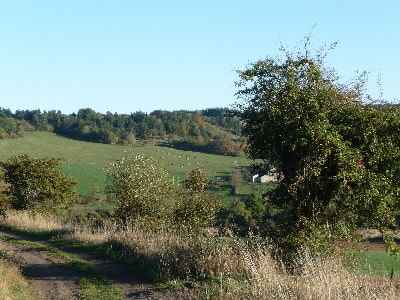 While the population remained quite strong for a long time, and life was sustainable, it was due to small-scale farming and supplemental activities: seasonal migration existed just like elsewhere. People would hire themselves for agricultural work in the southern regions or the Rhône valley. However, this movement is not comparable to that of the "traders" from Cézallier or Cantal, who brought wealth and comfort.
While the population remained quite strong for a long time, and life was sustainable, it was due to small-scale farming and supplemental activities: seasonal migration existed just like elsewhere. People would hire themselves for agricultural work in the southern regions or the Rhône valley. However, this movement is not comparable to that of the "traders" from Cézallier or Cantal, who brought wealth and comfort.
Work at home has been much more significant: the image of lace-makers is not only associated with the town of Le Puy but with the whole of Velay. In every farm, women had their "pillow" and worked for a city patron during the long winter evenings; even if the income was modest, it represented a welcome supplement. This diffusion of craftsmanship in the countryside undoubtedly recalls Livradois; Le Puy, like Ambert, provided work in this way. Today, the last rural lace-makers have disappeared, but efforts are being made to revive this activity, even if fashion changes and the low wages are hardly encouraging. Nonetheless, it remains true that lace-making played a significant economic and social role.
Finally, it should be noted that agriculture, if not throughout Velay, at least in the West and center, had production that, with intensive and exhausting labor, could be economically interesting: lentils, whose name is still associated with Velay in the public eye.
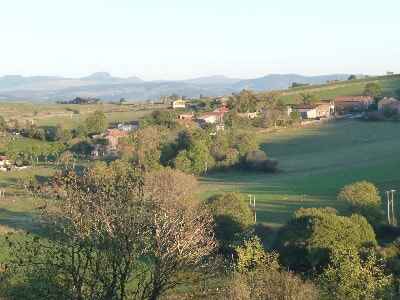 Cultivation developed within the framework of small family polyculture. Requiring much care and a great deal of work, it was quintessentially artisanal. However, in the context of a past agriculture that did not account for labor costs in its pricing, production could be rewarding during good years. Yet, the cultivation of lentils has hardly survived modernization: from 4,000 hectares in 1955, it dropped to 900 in 1980.
Cultivation developed within the framework of small family polyculture. Requiring much care and a great deal of work, it was quintessentially artisanal. However, in the context of a past agriculture that did not account for labor costs in its pricing, production could be rewarding during good years. Yet, the cultivation of lentils has hardly survived modernization: from 4,000 hectares in 1955, it dropped to 900 in 1980.
Haute-Loire, which, before World War II, produced nearly three-quarters of lentils in France, now provides less than 10%. The decline is significant despite the establishment of a professional organization. Lentils are now produced elsewhere, mainly in the southern Paris Basin. The local situation can be explained fairly well: too demanding in labor, the cultivation hardly accommodates the reduction in workforce due to exodus. Conversely, farms have not sufficiently expanded to engage in large-scale mechanized cultivation.
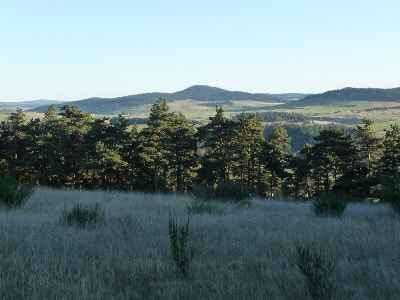 The small-scale agriculture practiced at high altitudes, along with the weakness of pastoral life, seasonal migration, lentil production, and lace-making: all these elements outline the contours of rural Velay. One should not forget the extraordinary social cement that religion represents. As with the neighboring Margeride, it is certainly the proximity of Protestant countries that explains the establishment, over past centuries, of one of the strongholds of the Catholic faith here. Religion still plays a very significant role in daily life, and many children attend private schools. It must be acknowledged that there is a powerful factor of unity here. But at the same time, Velay presents a nuanced face to the traveler.
The small-scale agriculture practiced at high altitudes, along with the weakness of pastoral life, seasonal migration, lentil production, and lace-making: all these elements outline the contours of rural Velay. One should not forget the extraordinary social cement that religion represents. As with the neighboring Margeride, it is certainly the proximity of Protestant countries that explains the establishment, over past centuries, of one of the strongholds of the Catholic faith here. Religion still plays a very significant role in daily life, and many children attend private schools. It must be acknowledged that there is a powerful factor of unity here. But at the same time, Velay presents a nuanced face to the traveler.
Beyond notions of high country, small farming, and a partitioned environment, diversity exists. In the center, the basin of Le Puy is a small "plain" at the heart of the mountains. To the west, the tablelands of Devès are the land of plowing. To the east, the great solitudes of Meygal and Mézenc stretch out. Finally, in the north, Yssingelais stands out with its tradition of small industry. The proposed routes will allow for the discovery of some of these multiple aspects. Black Glaciers, Covered Glaciers, Rocky Glaciers.
Unlike the great stratovolcanoes of Auvergne, Velay experienced very localized glaciation. In the eastern Mézenc, only small cirques contained tiny glaciers from which short tongues of ice escaped, quickly covered with blocks. The terms "black glacier" or "covered glacier" are used to describe such phenomena, with an example having already been described in Aubrac. These covered glaciers indicate a climatic context in which the amount of ice diminishes in favor of contributions from slopes (blocks provided by gelifraction): they are intermediate forms between glacial and periglacial forms. At their location today, there were tongues of block debris corresponding to the old cover of debris that concealed the ice. Covered glaciers can be distinguished from the rocky glaciers widely observed in eastern Velay (Mérenc, Meygal) as well as in southern Margeride. They consist of masses, tongues, or lobes of blocks that were bonded by a cement of ice, allowing the whole to flow. They indicate a periglacial environment.
Former holiday hotel with a garden along the Allier, L'Etoile Guest House is located in La Bastide-Puylaurent between Lozere, Ardeche, and the Cevennes in the mountains of Southern France. At the crossroads of GR®7, GR®70 Stevenson Path, GR®72, GR®700 Regordane Way, GR®470 Allier River springs and gorges, GRP® Cevenol, Ardechoise Mountains, Margeride. Numerous loop trails for hiking and one-day biking excursions. Ideal for a relaxing and hiking getaway.
Copyright©etoile.fr